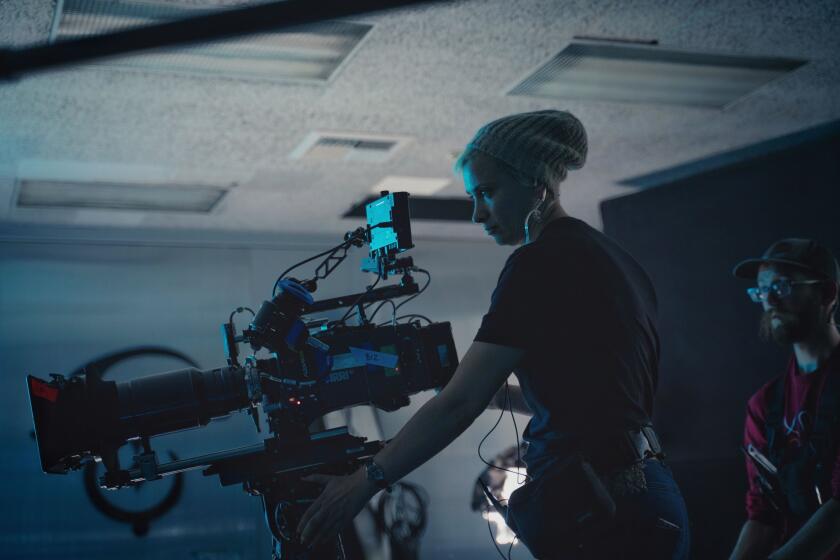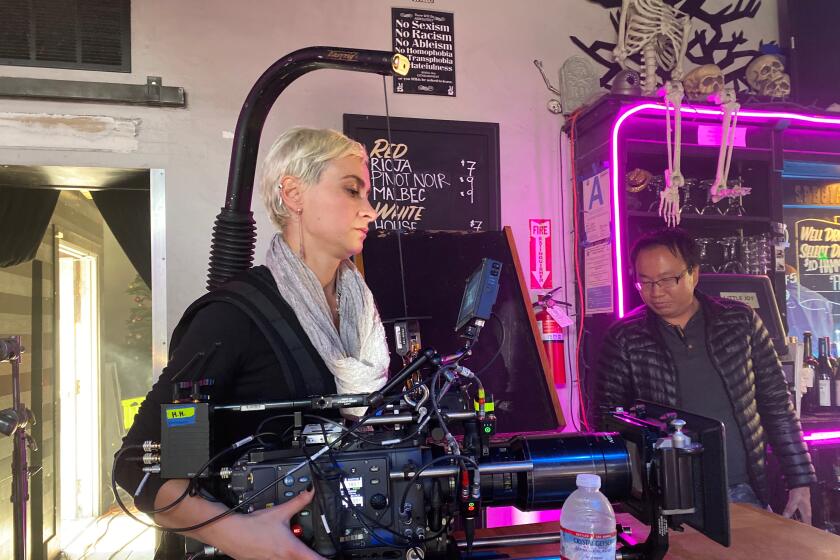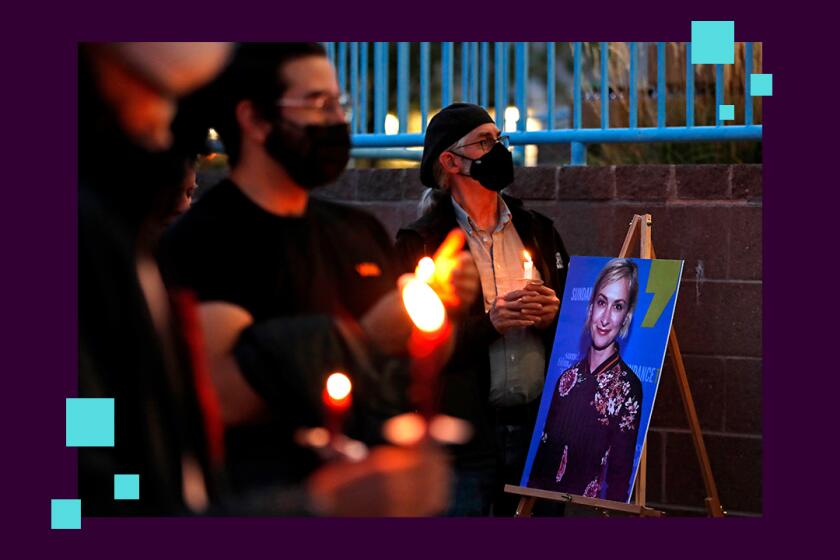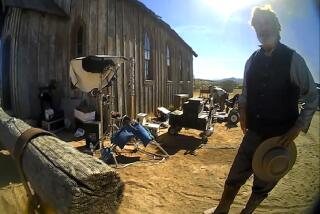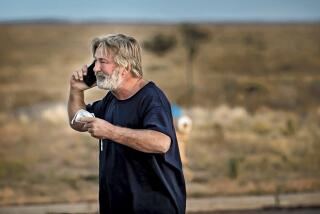Should guns be banned from film sets? Professional armorers push back

- Share via
After news broke of the Oct. 21 shooting that killed cinematographer Halyna Hutchins and injured director Joel Souza on the set of the western “Rust,” heartbreak rippled through an industry that has long established safeguards designed to prevent this kind of tragedy.
The fatal shooting was especially troubling for property masters and armorers, the professionals who oversee the use of weaponry in filming.
Among them is Hope M. Parrish, a 42-year veteran prop master, who like many colleagues was glued to the news and talking with peers trying to apply decades of experience to figure out how this could have happened.
“Every person I know that is seasoned in this, we were just a wreck,” said Parrish, whose credits include “Air Force One,” “Terminator 3: Rise of the Machines” and “Django Unchained.” “I’m angry, because none of this had to happen.”
The “Rust” shooting occurred during a rehearsal at Bonanza Creek Ranch in New Mexico when actor Alec Baldwin fired a live round from a revolver he had been assured was not loaded, a so-called cold gun. It was the first major gun-related fatality on a movie set since the death of “The Crow” star Brandon Lee in 1993 and at least the third in the nearly four decades since actor Jon-Erik Hexum died from a self-inflicted gunshot in 1984.
Cinematographer Halyna Hutchins was killed on the set of “Rust” in October 2021. A judge dismissed the involuntary manslaughter case against star Alec Baldwin in July 2024.
Armorers and other set professionals not related to the “Rust” production say industry protocols known as Safety Bulletins 1 and 2 are already well established to prevent such accidents. The first bulletin, crafted by a studio and union coalition, lays out rules such as never to have real bullets on a film set and to refrain from pointing a gun at a person.
“To have live rounds on a film set is the No. 1 no-no in our business,” said Gary Tuers, a prop master and owner of Xtreme Props and Weapons Rentals in Simi Valley, Calif. “So literally, the No. 1 rule in all of Hollywood was broken.”
Since the “Rust” shooting, efforts to further regulate on-set firearm usage have gained traction.
A group of working cinematographers, including Oscar nominee Rachel Morrison, has called on productions to end the use of functional guns on sets in Hutchins’ name.
Showrunners of ABC’s “The Rookie” and Amazon’s “The Boys” have pledged to use toy guns with VFX muzzle flashes rather than real firearms on their shows.
And Dwayne Johnson, whose Seven Bucks Productions produced Netflix’s “Red Notice” and the 2022 DC superhero title “Black Adam,” among others, became the first movie star to vow not to use real guns in his future projects.
A petition demanding Alec Baldwin use his power and influence to ban real guns on film sets amasses more than 19,000 signatures following the “Rust” movie set tragedy.
Last month, state Sen. Dave Cortese (D-San Jose) announced plans to introduce legislation banning live ammunition and firearms capable of shooting live ammunition on film and theatrical sets in California. In New York, state Sen. Kevin Thomas introduced a similar bill that would ban live ammunition on film sets in that state and require firearm safety training for cast and crew in scenes involving guns.
Meanwhile, a Change.org petition to ban real guns and live ammunition from movie sets nationwide has amassed more than 115,000 signatures.
But many armorers and prop masters say banning firearms is not the answer. They point to the inexperience of 24-year-old “Rust” armorer Hannah Gutierrez Reed, who had only one previous head armorer credit under her belt before she was hired on the low-budget independent production.
“The bottom line is that production just didn’t spend money where they needed to spend money, and that was on someone that was qualified, professional, experienced and safe,” Tuers said.
Tuers, who has worked as property master on films such as “G.I. Joe: Retaliation” and “The Magnificent Seven” and who supplied guns to the “John Wick” films, co-wrote a statement on behalf of several Hollywood armorers and weapon masters following the “Rust” shooting.
Describing the push to ban guns as “misguided,” the letter instead placed blame for the “completely preventable” tragedy on producers “unwilling to hire competent people following our long established and tested firearms safety procedures.”
After the shooting, Rust Movie Productions LLC said in a statement that the safety of its cast and crew was a top priority, that it was not made aware of any official complaints concerning weapon or prop safety on set and that it was cooperating with Santa Fe authorities on their investigation. No charges have been filed.
Hannah Gutierrez Reed had been hired for two different roles on the low-budget western, which made focusing on her job as armorer ‘extremely difficult,’ according to a written statement from the Albuquerque firm Gorence & Oliveros that was shared with The Times.
Seth Kenney, an Arizona-based weapons and props supplier who provided the guns, including the .45 Colt revolver Baldwin fired, has declined to comment on the fatal shooting.
The chief lighting technician on “Rust” recently filed a civil lawsuit in Los Angeles that alleges the film’s producers — including Baldwin — were negligent in Hutchins’ death. The suit alleges that prop master Sarah Zachry, Gutierrez Reed and first assistant director David Halls all “failed to thoroughly inspect” the gun before handing it to Baldwin.
Gutierrez Reed’s attorneys have said that safety was their client’s No. 1 priority on set, that she had no idea where the live rounds found on set came from and that the scene was tampered with before police arrived.
Halls told investigators that he did not check all the rounds in the gun before it was handed to Baldwin — a major breach of safety protocol. Halls’ attorney, Lisa Torraco, has since disputed the claim that he gave Baldwin the weapon or that he failed to examine the rounds in the chamber.
Baldwin, who was named in another lawsuit filed this week by the script supervisor on “Rust,” along with other producers and defendants, has not commented on the litigation.
He has said he is cooperating with investigators and has advocated having police on movie sets.
But Tuers and others said experienced armorers and weapons masters are more knowledgeable about and qualified to ensure the safe use of weapons on sets. Film armorers must hold various licenses, permits and certifications, with requirements varying from state to state.
“We work with guns every single day,” Tuers said. “A police officer has no business being there at all.”
Larry Zanoff, an armorer with a long list of film and TV credits, including “Westworld” and Marvel’s “Ant-Man,” said it is the responsibility of production to provide a safe working environment.
“If the procedures were not followed to the letter, as far as safety and security and chain of custody, that is because the people in place to perform that job were not the correct people,” said Zanoff.
Zanoff is lead armorer and assistant weapons manager at Sunland, Calif.-based Independent Studio Services, which supplies firearms to productions. The prop house has more than 150,000 live weapons in its inventory, including blank firing guns and antiques, and makes about 15% of its annual revenue from its arsenal, according to Chief Executive Gregg Bilson.
Zanoff estimated there are five prop houses nationwide that modify weapons and provide them to the industry. Independent Studio Services also owns High Desert Theatrical Blanks. The company provides the prop house and its clients with blank ammunition, which generate a flash and sound when fired but don’t contain lead bullets.
Some in Hollywood say real firearms should be banned from film sets after the death of Halyna Hutchins.
Some directors and cinematographers have argued that gunfire can be re-created affordably and realistically using computer-generated effects rather than real guns.
But many armorers (and some filmmakers) disagree and argue that a ban on real weapons from film and TV sets would devastate their livelihoods.
Los Angeles County is home to at least 66 armorers, who belong to Local 44 of the International Alliance of Theatrical Stage Employees.
“Most productions have firearms in them,” Zanoff said. “That’s a chunk of the income for businesses like ours in the industry that will go away or quite honestly will be forced out of the state.”
If California were alone in legislating against the use of real firearms in movies, or the industry here were to unilaterally stop using them, companies could continue to ship to other locales. “If you had the industry just move elsewhere, we would just manufacture stuff and ship it elsewhere,” Zanoff said.
Zanoff also called for an industry standard of training for armorers across the U.S. and internationally.
More lucrative tax incentives have drawn many productions away from California to other states like New Mexico. Veteran prop master Parrish blames an increased demand for content from studios for drawing filming to other states where there are fewer experienced armorers.
Some armorers note that New Mexico does not require the same number of licenses to operate guns as does California.
Albuquerque-based armorer Scott Rasmussen, a member of IATSE Local 480, said he also is opposed to banning of real weapons on sets, which he sees as a threat to his livelihood.
“It’s an unnecessary move,” he said. “I won’t lie to you. I’m very concerned about it. It’s not taking into account the many people whose lives they’re going to put out of business. In other words, I’ll be losing my job.”
Rasmussen has 48 years of experience with guns, including as armorer for the Margot Robbie movie “Dreamland” and the Natalie Portman western “Jane Got a Gun.”
Armorers ultimately fall under the jurisdiction of a production’s prop master and prop department. To make things safer, Rasmussen believes a weapons safety department needs to be established, separate from the props department in productions.
“But this is just an added assurance that we have one department whose sole mission in the film industry is to ensure that this does not happen again,” he said. “Props, they’re busy. Let’s alleviate some of that worry from them.”
Rather than ban guns from productions, Parrish proposed film producers invest in training more armorers to meet demand.
“It’s about educating people, and it’s about educating producers. You can’t keep hiring people who aren’t qualified just to get your movie made because you have a time constriction,” Parrish said. “Getting rid of the guns is not going to get rid of the problem.”
More to Read
Only good movies
Get the Indie Focus newsletter, Mark Olsen's weekly guide to the world of cinema.
You may occasionally receive promotional content from the Los Angeles Times.
